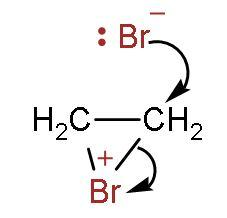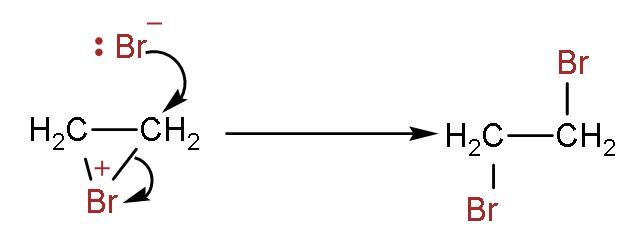
When an alkene is mixed with bromine water:
A. The bromine water changes from orange to colourless
B. The bromine water stays orange
C. The bromine water changes from colourless to orange
D. The bromine water change from brown to colourless
Answer
503.4k+ views
1 likes
Hint: Alkenes react with a solution of bromine in an organic solvent like tetrachloromethane. The double bond breaks out and bromine atoms get added to each carbon. The reaction is marked by the change in the colour of the solution.
Complete answer:
The reaction between alkene and bromine water is an example of electrophilic addition. Bromine has ionic properties:
Step (1)- The bromine-bromine bond breaks to form bromonium ion. Bromine atoms induce the charge to double bond and attack the carbon atoms. The structure formed is triangle-shaped.

Step (2)- The bromonium ion is attacked from the back side due to hindrance faced on the same side by bromide ion.

Step (3)- It attaches to other double bonded carbon, and thus the product is formed. The two bromine atoms are attached to both carbon atoms containing double bonds.

As a result, the bromine water loses its original red-brown or orange colour to give a colourless liquid. So, the correct answer is “Option A”.
Additional Information: This decolourisation of bromine is used as a test for presence of carbon-carbon double bond in the hydrocarbons. This technique is used to distinguish between alkenes and alkanes.
Note: Not all compounds having double bonds show this reaction of addition of bromines. Such compounds include benzene. Benzene has three double bonds in it, but still does not leave bromine water colourless. This reaction does not occur because benzene does not undergo electrophilic addition reaction on addition of bromines, the aromaticity of benzene would have been lost. The 6 pi electrons (
Complete answer:
The reaction between alkene and bromine water is an example of electrophilic addition. Bromine has ionic properties:
Step (1)- The bromine-bromine bond breaks to form bromonium ion. Bromine atoms induce the charge to double bond and attack the carbon atoms. The structure formed is triangle-shaped.

Step (2)- The bromonium ion is attacked from the back side due to hindrance faced on the same side by bromide ion.

Step (3)- It attaches to other double bonded carbon, and thus the product is formed. The two bromine atoms are attached to both carbon atoms containing double bonds.

As a result, the bromine water loses its original red-brown or orange colour to give a colourless liquid. So, the correct answer is “Option A”.
Additional Information: This decolourisation of bromine is used as a test for presence of carbon-carbon double bond in the hydrocarbons. This technique is used to distinguish between alkenes and alkanes.
Note: Not all compounds having double bonds show this reaction of addition of bromines. Such compounds include benzene. Benzene has three double bonds in it, but still does not leave bromine water colourless. This reaction does not occur because benzene does not undergo electrophilic addition reaction on addition of bromines, the aromaticity of benzene would have been lost. The 6 pi electrons (
Recently Updated Pages
Basicity of sulphurous acid and sulphuric acid are

Master Class 12 Economics: Engaging Questions & Answers for Success

Master Class 12 Maths: Engaging Questions & Answers for Success

Master Class 12 Biology: Engaging Questions & Answers for Success

Master Class 12 Physics: Engaging Questions & Answers for Success

Master Class 4 Maths: Engaging Questions & Answers for Success

Trending doubts
Give 10 examples of unisexual and bisexual flowers

Draw a labelled sketch of the human eye class 12 physics CBSE

a Tabulate the differences in the characteristics of class 12 chemistry CBSE

Differentiate between homogeneous and heterogeneous class 12 chemistry CBSE

Why is the cell called the structural and functional class 12 biology CBSE

Differentiate between insitu conservation and exsitu class 12 biology CBSE




